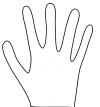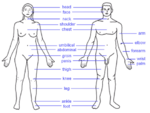Index finger
| Index finger | |
|---|---|
|
|
|
| Human hand with index finger extended | |
| Artery | radial artery of index finger |
| Fingers |
 |
The second digit of a human hand is also referred to as the index finger, pointer finger, forefinger, trigger finger, digitus secundus, or digitus II.
It is located between the first and third digits - that is, between the thumb and the middle finger. It is usually the most dextrous and sensitive finger of the hand, though not the longest. A lone index finger often is used to represent the number 1, or when held up or moved side to side (finger-wagging), it can be an admonitory gesture. With the hand held palm out and the thumb and middle fingers touching, it represents the letter d in the American Sign Language alphabet. In sports, it can also represent victory, as some championship-winning teams raise their index finger (often saying "We're number one!") while posing for a championship team photo.
Men are 2.5 times more likely than women to have an index finger which is shorter than their ring finger, and such ratios correlate with an increased likelihood of osteoarthritis, especially for women with such ratios.[1]
Contents |
Gestures
As mentioned above, the forefinger can be used for pointing. However, this gesture is considered rude in some countries (Ukraine, Russia and Chile for instance), in the former two pointing with the whole hand is considered polite.
During the Bosnian war, Serbo-Bosnian troops raised three fingers in a sign of victory, Bosnian Croats raised the two-finger V-sign and Muslims (Bosniaks) raised one (after the strict monotheism of Islam).
See also
- Extensor indicis proprius
- Index (typography)
- Digit ratio
Additional images
References
- ↑ Arthritis & Rheumatism. news release, Jan. 2, 2008
External links
- index+finger at eMedicine Dictionary
|
|||||||||||||||||||
